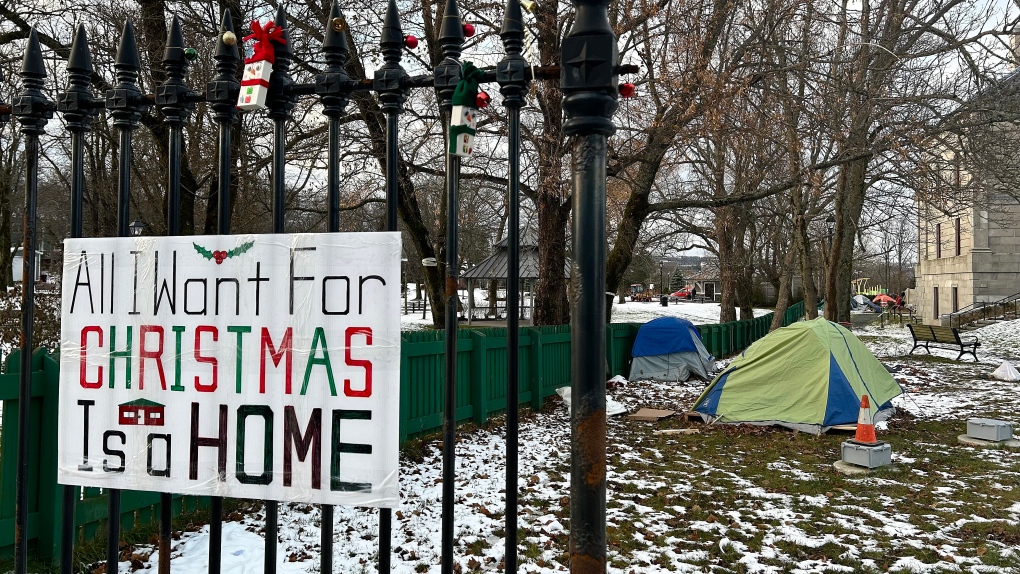An artificial intelligence algorithm has crunched the numbers for how many people in Canada could be homeless by 2030.
According to the predictive AI by HelpSeeker, a Calgary technology company working to address social problems, Canada’s homeless population will almost double in the next six years.
“That doesn’t mean that we’re going to be looking at visible homelessness,” Alina Turner, CEO of HelpSeeker, said in a press conference Monday. “We have layers of visibility, we have rough sleeping, an encampment, we’ve got people that are in those unsafe situations (and) we have people that are couch surfing.”
Currently, estimates by the Homeless Hub, a research organization run by York University, peg the number of people experiencing homelessness in Canada somewhere between 150,000 to 300,000. By 2030, the AI predicts the population of people experiencing homelessness to grow to about 550,000 to 570,000.
HelpSeeker’s AI used data from municipalities across the country including shelter usage, hidden homelessness estimates, inflation trends, unemployment numbers and other factors like housing and rental stock.
One of the key sets of data for the AI is the predicted population growth of the country, which is set to be around 50 million in the next six years, according to Statistics Canada.
Predictions from HelpSeeker’s AI on how many people in Canada that will be homeless by 2030. (HelpSeeker)
Compounding all these factors, the AI predicted that homelessness is likely to increase by roughly 83 per cent by 2030.
Due to a lack of data, Turner said it’s unclear exactly what Canada’s current at-risk homelessness statistics are. The population of Canadians at risk of homelessness is projected, however, to be close to one million by the end of the decade.
Hidden homelessness, which describes people who could be couch surfing and not presenting at shelters, is expected to reach around 300,000 people by 2030, the AI predicts.
Similarly, with other homelessness population counts, there are no numbers able to represent how many people in Canada are currently under this category. The Homeless Hub’s website estimates as many as 50,000 people are experiencing hidden homelessness on a given night in Canada.
Furthermore, the AI noted people living in absolute homelessness, or those who have no physical home and spend nights in emergency shelters, will reach around 200,000 people by 2030.
HOW DO WE CLOSE THE GAP?
Preventing these predictions from becoming true will require concrete action across the country, researchers from HelpSeeker say.
“It’s going to take a lot, it’s going to take complex care and supportive housing beds,” Turner said.
 HelpSeeker’s predictive AI and researchers believe Canada needs to invest about $169 million to close the gap for homelessness. (HelpSeeker)
HelpSeeker’s predictive AI and researchers believe Canada needs to invest about $169 million to close the gap for homelessness. (HelpSeeker)
Researchers believe by 2030 an increase of 103,000 beds with medical care, 1.3 million non-market housing units, 50,000 recovery and transitional care beds and 30,000 emergency shelter beds would help tackle the issue of homelessness in Canada.
“If we’re not able to build these systems now, these trajectories are going to go unchanged,” Turner said.
The federal government did not immediately respond to a request for comment.
HOW MUCH WILL IT COST?
If Canada used funding geared toward the “right interventions,” Turner said, the homelessness numbers would look very different in the next six years.
It will cost Canada more than $169 billion to build the total emergency shelters and social or subsidized housing needed, HelpSeeker estimates.
However, to maintain these supports and prevent more people from being homeless, each year the costs will be around $16 billion, the company said.
“The good news is, we do have about a trillion dollars every year that is going into the social safety net,” Turner said. “It’s going into everything from addiction to mental health, homelessness and housing instability and community personal safety. So can we afford it? First of all, we can’t afford not to.”
Several stakeholders from other organizations and municipalities also raised concern at the lack of action they’re seeing.
Susan McGee, CEO of Homeward Trust an Edmonton homelessness organization, said investment into social safety nets and housing has a “real-time” impact on people and that Canadians cannot wait any longer for these investments.
“We have seen a really significant increase in deaths directly related to being unsheltered,” she said at the press conference. “This is immediate and urgent and we need to treat it like the crisis that it is.”
Jamie Lloyd-Smith, a social development specialist with the City of Penticton, B.C., shared similar concerns.
Lloyd-Smith said her community of about 37,000 has seen a large population growth, which has spiked the demand for affordable housing.
Without funding from higher levels of government, she said the community is struggling to support its homeless population.
“I often say we were too small to be a big city, but we were too big to be a small city, and so from a funding and resource perspective, we were often left out of some of those funding calls,” she said.




